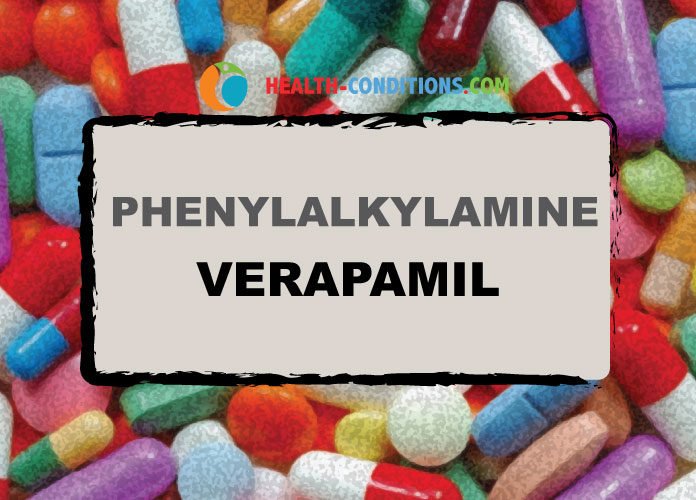PHENYLALKYLAMINE: VERAPAMIL
GENERAL DESCRIPTION
Verapamil is the first clinically available Calcium channel blocker. It is it is an alkaloid vasodilator. Verapamil is less potent calcium channel blocker than amlodipine but more potent than diltiazem.
GENERIC NAME: Verapamil
BRAND NAME Calan, Isoptin, Verelan
MECHANISM OF ACTION
Cardiovascular response of verapamil is shown in following steps
Firstly, verapamil decrease myocardial contractile force which reduces myocardial oxygen requirements. Secondly, verapamil inhibits calcium influx into arterial smooth muscles resulted in decreased arteriolar tone and systemic vascular resistance. This process decreased the arterial and intraventricular pressure. As a result of all these steps, left ventricular wall stress decline and which reduces myocardial oxygen requirements. SA nodes and AV nodes, which are mainly composed of calcium channels are markedly effected by verapamil thus decreases atrioventricular nodal conduction and is effective medicine in supraventricular tachycardia and also decreasing ventricular responses in atrial fibrillation or flutter.
Cardiovascular effects of Verapamil
- Vasodilation: High
- Suppression of cardiac contractility: High
- Suppression of automaticity (SA node): High
- Suppression of conduction (AV node): High
PHARMACOKINETICS
Verapamil is given orally and also intravenous route. The oral bioavailability of verapamil is 20-35% and plasma half-life is 6 hours. Verapamil absorption from the gut is reduced by p-glycoprotein. Verapamil is metabolized by CYP3A4 enzyme or cytochrome P450 system.
INDICATIONS
- Dysrhythmia
- SR preparation for hypertension
- Supraventricular tachyarrhythmia
- Decrease coronary vascular resistance
- Variant Angina
- Exertional Angina
- Unstable angina
- SR preparation for hypertension
- Myocardial Infarction
- Hypertension
- Prophylaxis of migraine
CONTRAINDICATIONS
- Hepatic dysfunction
- Ventricular dysfunction
- SA and AV nodal conduction disturbance
- Systolic blood pressure below 90 mmHg
- Hypersensitivity
- Hepatic cirrhosis (can use with dose adjustment)
- Second or third degree heart block
- Bradycardia
SIDE EFFECTS & ADVERSE EFFECTS
- Constipation
- Negative ionotropic action
- Bradycardia
- Exacerbation of heart failure
- Ankle swelling (oedema)
- Dizziness
- Flushing
- Urinary retention (less)
- Headache
- Dizziness
- Nausea
- Vomiting
DRUG INTERACTION
- Verapamil IV and beta blockers when given concurrently, can cause circulatory collapse
- Verapamil IV and beta blockers when given concurrently, can cause circulatory collapse
- Grape fruit juice may increase the bioavailability of verapamil.
- Verapamil can cause digoxin toxicity when given concurrently.
- When use with Quinidine, verapamil can cause hypotension.
- The absorption of Verapamil may be modestly reduced when given with antineoplastic regimen containing cyclophosphamide, vincristine, procarbazine or doxorubicin, vindesine, cisplatin.
- NSAIDs may reduce the hypotensive effects of verapamil. NSAIDs may cause internal bleeding and bruises when used with verapamil.
- Drugs containing azole can increase the serum level of verapamil, which further increase adverse effect of oedema in patients
- Verapamil given orally with Calcium or calciferol have shown the antagonizing effects on antiarrhythmic effects of verapamil.
- Chlorpromazine and other phenothiazine can cause severe hypotension when used with verapamil.
- Dantrolene may cause acute hyperkalemia and cardiovascular collapse when given with verapamil.
- Combination of diuretics and verapamil can increase antihypertensive effects.
- Verapamil may increase adverse effects (oedema, headache, vomiting, flushing, and orthostatic hypotension) when use with Fluoxetine.
NURSING INTERVENTION
- Inquire complete health history of patient.
- Monitor blood pressure and pulse before and during therapy
- Check fluid intake and output.
- Check peripheral oedema, rashes and other s/s related to the medicine
- Monitor BUN, serum potassium, creatinine, AST, ALT, serum bilirubin level
PATIENT EDUCATION
- Counsel the right time and dosage of medicine.
- Instruct patient how to count pulse and if pulse is less than 55 inform health practitioner.
- If patient taking Nifedipine, forbid to use grapefruit juice.
- Avoid the use of alcohol while taking medicine.
- Don’t adjust the missed dose.
- Avoid OTC and NSAIDs concurrently with medicine.
- Consult doctor prior to the use of herbal or other multivitamins supplements
- Instruct patient to take caution while changing the posture.
- Counsel patient with the possible side effects of the medicine and inform if feel any.













